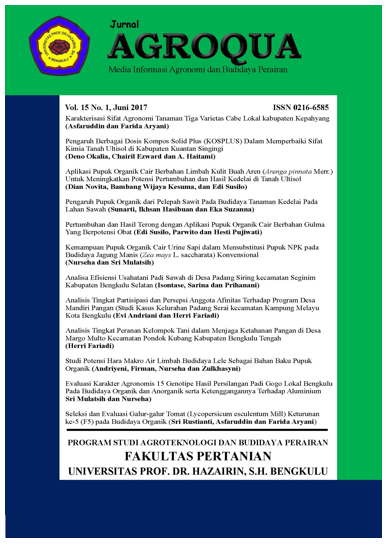ANALISIS FILTER BIOLOGI CACING SUTRA (Tubifex sp.) DENGAN LUAS WADAH YANG BERBEDA TERHADAP PERTUMBUHAN DAN KUALITAS AIR IKAN LELE SANGKURIANG (Clarias gariepinus)
DOI:
https://doi.org/10.32663/ja.v19i1.1793Keywords:
Biological filters, recirculation, silkworms, the quality of the culture environmentAbstract
The use of biological filters for silkworms (Tubifex sp.) With different container areas for growth and improvement of water quality in the cultivation of Sangkuriang catfish (Clarias gariepinus). The research objective was to determine the best level of silk worm container in utilizing catfish culture waste to improve the water quality of sangkuriang catfish (Clarias gariepinus) culture and to see the growth rate of catfish. The design used was a completely randomized design with 3 treatments and 4 replications. Treatment P1: Catfish cultivation with 1 silk worm cultivation level, P2: Catfish cultivation with 2 silk worm cultivation levels, and P3: Catfish cultivation with 3 silk worm cultivation levels, and each like catfish cultivation with a stocking density of 75 fish / m2. The results of this study indicate that the best treatment on P3, (13,412.83) is significantly different from P2 (11.234.70) and P1 (11.400.87), and has a significant effect on absolute length, absolute weight, and conversion, but has no effect. Significant to the average survival of treatment P1 (92.00), P2 (96.33) and P3 (98.33), and the best catfish water quality was in treatment (P3) with three levels of silk worms. Utilization of catfish culture waste to the growth of individual numbers and biomass weight of silkworms (Tubifex sp.), The number of individuals, namely 76.88 thousand m2 and biomass weight of 0.208 kg
References
Downloads
Published
Issue
Section
License
Authors who publish with this journal agree to the following terms:
- Authors grant the journal right of first publication with the work simultaneously licensed under a Creative Commons Attribution 4.0 Internasional (CC BY 4.0) Licence that allows others to use and share the work with an acknowledgment of the work's authorship and initial publication in this journal.
- The author(s) still hold the copyright of his/her/their work and retain publishing rights without restrictions such as (but not limited to) patent right, lecture, book and reproduce the article for own purposes.
















